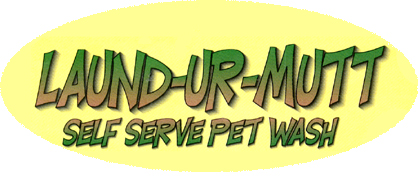Your groomers's basic training DOES matter!
As a long time groomer (23 years) and shop owner (17 years), I have noticed a decline in haircut quality from the younger generation of groomers and have FINALLY zeroed in on a common denominator. It’s not their lack of love for animals or their newness to the trade, as you might guess. Nope, it’s their desire to leap without learning. Groomers that use tools designed for more skilled or adept groomers will certainly not grow in their skills, because they have missed the very foundation of the skillful art of sculpture with the basic tools before trying the tools that enhance established skill. Here-in we will discuss a small facet of what makes a groomer great.
Choice of the SHEARS they use; especially on the face.
I recently had the pleasure of employing a sweet, endearing, crafty, intelligent, young lady that was super sweet to the animals that she groomed, showed character in her relationships with staff/clients, and had integrity in her work ethic (rarely missed work or called off). Let’s say her name is Grace. All the things that make a great groomer, right? Yep. She was great. However, she could have been better. The quality of her heads and faces… good, but not the greatest. When I first viewed her work, many of her heads and faces were SO uneven. Almost like she didn't SEE the long and short pieces of hair that didn't blend….
This is QUITE important when grooming pets. When people look at their pets daily, they look at their faces. If you, as a groomer, have a choice of one or the other body-legs or face looking less than perfect, it MUST be the body. If the face looks bad, the whole grooming looks bad. The pet doesn’t look like “himself”.
Right off the bat I noticed something was wrong. I found myself “cage trimming” a lot of her faces. (Cage trimming is when the groomed pet is complete, and you find something that looks uneven, and instead of taking the pet back to your grooming table, you take the shears to the cage, and fix it. I sometimes do this to pets that other master groomers in my salon have trimmed for various reasons: they don’t have the time, they have left for the day, they didn't see what the dog shook out after the groom was finished, to save face for the groomer, etc.) I watched as Grace would take pride in her work and did not want to insult the quality of her nature, by pointing out that her work wasn’t the highest quality that I thought she was capable of. I decided on a more diplomatic approach. I watched and waited for teachable moments.
What did I see??
She was using thinning Shears (single blade with a comb instead another blade)
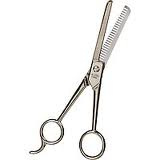
not Grooming Shears (two blades that cut, curved or straight) 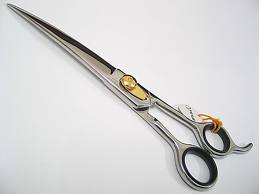
Grooming Shears come from a variety of manufacturers but choosing and mastering them can be a long course in patience; learning from others, trying them on at trade shows, and seeing what your work looks like using them. Groomer Grace used them on the body, legs, and tail, but abandoned them on the head/ face. Why?? I asked her. “Because it looks natural, I like it more natural looking” and “That’s how I learned”. It became clear to me. No one had taught groomer Grace to use shears that can SHOW MISTAKES. She had been taught to hide mistakes that she hadn’t learned to make to begin with. This is VERY backwards and robs younger groomers of a skill that they so desperately need to compete in the industry. ONLY a very trained hand can cut an entire head with thinning shears (I know, I am using them now after years of not doing so. IT’S HARD). The experience that comes from using grooming shears, AND MAKING MISTAKES is the very foundation of how you learn symmetry with different coats. The very mistakes that you make force you train your whole upper body to lock your wrist, move your arm (not your hand), and time your cuts with every slight movement of the pet.
IT TAKES 3-10 TIMES AS MANY CUTS IN THE SAME EXACT PLACE TO MAKE THE SAME CUT WITH THINNING SHEARS AS WITH 1 CUT WITH GROOMING SHEARS, however, it will look more blended… natural. Without miniscule movements while scissoring, it will look UNEVEN not NATURAL.
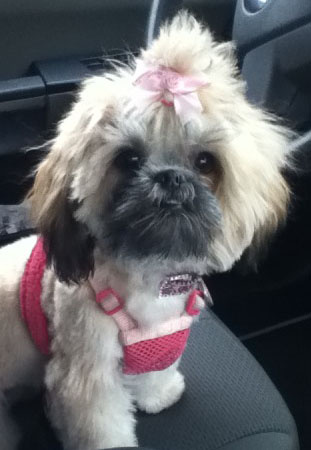
BAD
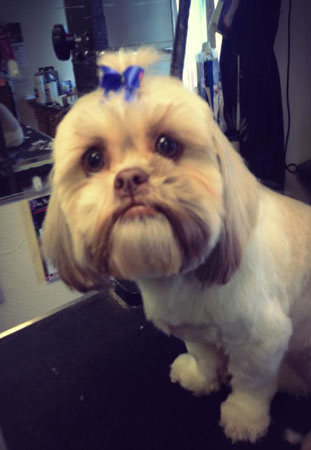
GOOD
(Bad/ Good not being length or style, but symmetry and balance.)
Groomer Grace had been taught to cut the hair WAY too many times in order to cancel out any mistakes that would happen along the way. In turn, she never learned to lock her wrist and was careless about scissoring in the EXACT same spot. End product? She had long pieces, short pieces, over trimmed areas, under trimmed areas, and lack of symmetry lending to a less attractive over all grooming of the face/head. When I tried to help her unlearn this, (by talking, teaching others and teasing her), I came against a ridged opinion that I was wrong. Because this was how she had been taught. Sometimes it is MUCH harder to unteach, than to teach. (I think that she only relinquished because it was my preference as the salon owner, and used thinning shears less when I was around or watching.)
THERE ARE PRO GROOMERS AND BIG PET CHAIN STORES OUT THERE TEACHING THIS FORM OF GROOMING FACES TO NOVICE GROOMERS.
These pros have long and illustrious careers and the expertise to maneuver such a high-mastered skill. They make videos and hold seminars that definitely show off their skills, but leave their students clueless. BEWARE!
Groomer Grace has since moved on to another pet salon and I had the pleasure of seeing her at one of these seminars. When the presenter talked about thinning shears and I asked a question (hey, I don’t know EVERYTHING)… I caught the giggles, whispering and looks from her peers, younger more “hip” groomers, that were scoffing at me because of the stories they’d heard of me encouraging groomer Grace to hone her skills with grooming shears, and lay down her thinners. That made me very sad. She had missed the whole point. It was never that she wasn't doing it right, just that she wasn't doing it right, right now.... For, one of the goals of my career is to help the next generation of groomers to be BETTER than the last. Learn from us, the older more experienced groomers. Sometimes it’s just not about ego. I want you to be better than me. You should be, just from having groomed next to me!
I am now, after 23 years of grooming, doing some AMAZING looking pet grooms using thinning shears and “chunkers”. A talent that I feel I have just NOW aspired to. I have to be precise 5x as often when grooming with them (a really expensive pair help a lot! LOL).
Seriously though, if you are a client looking for a good, high quality, groomer (besides a kind one, that is sweet to your furry friend), ask what kind of shears they use on the head/face, and how long they have been grooming. If the answer is thinning shears or chunkers and they have been grooming less than 5-6 years, choose a different groomer… even at the same salon. If you are a young/newer groomer that has been taught to groom heads this way. Do yourself a favor, I ask you to use thinning shears sparingly. Stop hiding behind “It looks natural” when CLEARLY it’s uneven. When you have your arm, wrist and hand trained to lock and not bounce up and down or in and out while you scissor; you will find using thinning shears a new challenge that your are ready for. You will finally REALLY pass up the older generation of groomers that refuse to grow, and learn new “tricks of the trade”. Hopefully, you will eventually put all us “old fogies” out of business. But until then, my heads and faces will always look better, because I continue to strive for excellence. And my hope is that every groomer would care enough to put aside petty differences and recognize their weaknesses AND strengths.
A pet groomer's initial training can be a solid platform from which they can build an exemplary set of skills or it can leave them lacking the foundation that they need to excel.
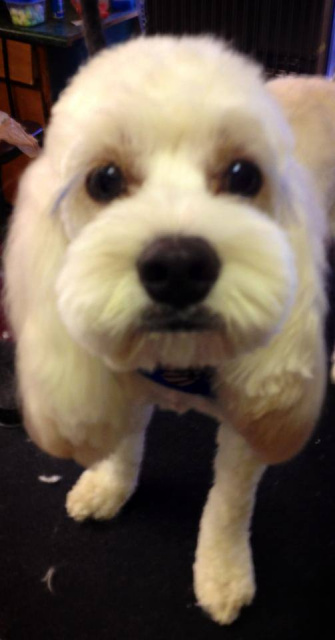
(done completely with thinning shears)
PLEASE NOTE: This article in no way means to focus on a particular groomer's failures. It is to point out that a groomer's initial training is very important when they try to advance in skill to more difficult trims for more discriminating pet owners, or in a salon that has a higher than average expectation of it's groomers skill and potential. The average groomer can often accommodate most pet trims and owner's adequately, especially considering that most pet owners rate the quality of the haircut under the way they and their pet is treated. The personal experience that I describe is only an example of ONE groomer, in ONE salon. The groomer that I talk about in this article was well liked by our staff, clients, pets, me, and was not by any means a BAD groomer overall.
Here at my salon, we have 7 groomers of varying skill level. We are fortunate to have 3 EXTREMELY SKILLED groomers that can please even the most discriminating pet owners.


